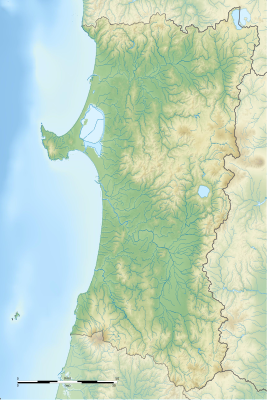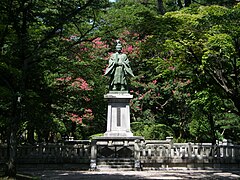Kubota Castle
| Kubota Castle | ||
|---|---|---|
|
View of the main gate |
||
| Creation time : | 1603 | |
| Castle type : | Hirayamajiro (hill castle) | |
| Conservation status: | Preserved (reconstruction) | |
| Place: | Akita | |
| Geographical location | 39 ° 43 '23 " N , 140 ° 7' 25" E | |
| Height: | 38 m TP | |
|
|
||
The Kubota Castle ( Japanese 久保 田 城 , Kubota-jō ) was the seat of the Satake in Akita , Akita Prefecture .
history
Satake Yoshinobu ( 佐 竹 義 宣 ; 1570-1633) from the Satake clan was one of the great daimyo of the Sengoku period . After the Battle of Sekigahara, however, not only was his income reduced from 545,000 Koku to 250,000, but he also had to move from Mito to remote Akita. There he took over the Tsuchizaka-minato castle built by the Andō (Akita). Since the castle was too small for him, however, he began to build the Kubota castle nearby in 1603, which was essentially completed the next year so that he could move into it. He also expanded the town and the temple district, so that a typical castle town was created. After that 13 generations of Satake ruled the property from here.
The attachment
The hill Shimmeiyama (神明 山) was used for the Hommaru (本 丸, 1) of the castle. Below the Ni-no-maru (二 の 丸, 2) was created, which was protected by the inner ditch. San-no-maru (三 の 丸; 3), the lower castle area (下 中 城; 4), Kita-no-maru (北 の 丸; 5), Nishi-kuruwa (西 曲 輪) and other castle areas were also laid out. The fortification consisted of earth walls, only the gate areas were protected by stone walls.
In the main castle, a two-story watchtower (櫓) and three other watchtowers were used in place of a castle tower, which were supplemented by ramparts. The main castle was also home to the Shoin style residence . In the Ni-no-maru there was a place to ride the horses (馬 場, P), in the west below a herb garden (御 薬 園, Oyakuen; K). In the lowest part of the castle on the south side there were also residences for higher Samura (S).
Due to various fires, most recently in 1880, no buildings have been preserved except for the main gate of the Hommaru and the ( relocated ) guard house Omonokashira gobansho ( 御 物 頭 御 番 所 ). One of the eight corner watchtowers was rebuilt in 1988.
The castle grounds are used as a park under the name Senshū-kōen ( 千秋 公園 ).
photos
Remarks
- ↑ The main gate called Ichi-no-mon ( 一 ノ 門 ) was originally part of a box-shaped gate system with two gates.
literature
- Mizoguchi, Yasutsune: Kubota-jo in: Miura, Masayuki (ed.): Shiro to jinya . Tokoku-hen. Gakken, 2006. ISBN 978-4-05-604378-5 .
- Akita-ken no rekishi sampo henshū iinkai (Ed.): Akita-ken no rekishi sampo . Yamakawa Shuppan, 2001. ISBN 978-4-634-24605-8 . P. 128.
- Nishigaya, Yasuhiro (Ed.): Kubota-jo In: Nihon meijo zukan, Rikogaku-sha, 1993. ISBN 4-8445-3017-8 .







